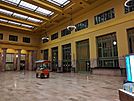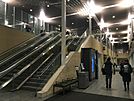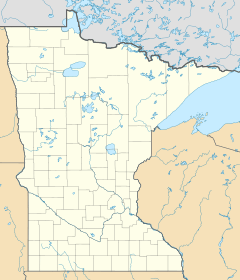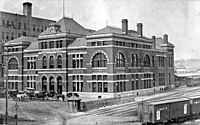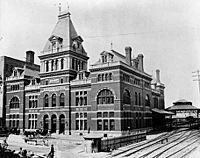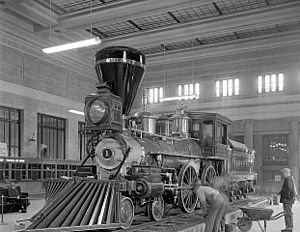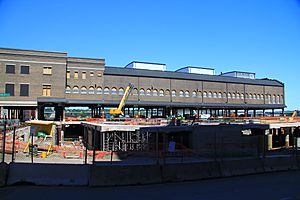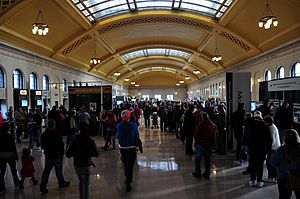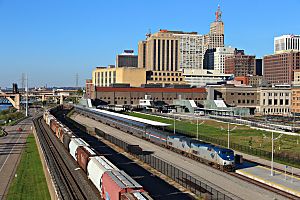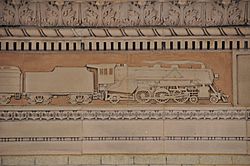Saint Paul Union Depot facts for kids
Quick facts for kids
Union Depot
|
||||||||||||||||||||||||||||||||||||||||||||||||||||||||||||||||||||||||||||||||||||||||||||||||||||||||||||
|---|---|---|---|---|---|---|---|---|---|---|---|---|---|---|---|---|---|---|---|---|---|---|---|---|---|---|---|---|---|---|---|---|---|---|---|---|---|---|---|---|---|---|---|---|---|---|---|---|---|---|---|---|---|---|---|---|---|---|---|---|---|---|---|---|---|---|---|---|---|---|---|---|---|---|---|---|---|---|---|---|---|---|---|---|---|---|---|---|---|---|---|---|---|---|---|---|---|---|---|---|---|---|---|---|---|---|---|---|
|
Left to right from top:facade of the head house, waiting room, concourse, inside of the headhouse, Entrance from lower parking ramp with ticket stations for Jefferson Lines and Amtrak
|
||||||||||||||||||||||||||||||||||||||||||||||||||||||||||||||||||||||||||||||||||||||||||||||||||||||||||||
| Location | 214 Fourth Street East Saint Paul, Minnesota 55101 United States |
|||||||||||||||||||||||||||||||||||||||||||||||||||||||||||||||||||||||||||||||||||||||||||||||||||||||||||
| Coordinates | 44°56′52″N 93°5′10″W / 44.94778°N 93.08611°W | |||||||||||||||||||||||||||||||||||||||||||||||||||||||||||||||||||||||||||||||||||||||||||||||||||||||||||
| Owned by | Ramsey County Regional Railroad Authority | |||||||||||||||||||||||||||||||||||||||||||||||||||||||||||||||||||||||||||||||||||||||||||||||||||||||||||
| Operated by | Jones Lang LaSalle | |||||||||||||||||||||||||||||||||||||||||||||||||||||||||||||||||||||||||||||||||||||||||||||||||||||||||||
| Line(s) | Canadian Pacific Railway Merriam Park Subdivision | |||||||||||||||||||||||||||||||||||||||||||||||||||||||||||||||||||||||||||||||||||||||||||||||||||||||||||
| Platforms | 9 historically 3 currently |
|||||||||||||||||||||||||||||||||||||||||||||||||||||||||||||||||||||||||||||||||||||||||||||||||||||||||||
| Tracks | 18 historically 2 currently |
|||||||||||||||||||||||||||||||||||||||||||||||||||||||||||||||||||||||||||||||||||||||||||||||||||||||||||
| Bus routes | ||||||||||||||||||||||||||||||||||||||||||||||||||||||||||||||||||||||||||||||||||||||||||||||||||||||||||||
| Bus stands | 6 | |||||||||||||||||||||||||||||||||||||||||||||||||||||||||||||||||||||||||||||||||||||||||||||||||||||||||||
| Bus operators | ||||||||||||||||||||||||||||||||||||||||||||||||||||||||||||||||||||||||||||||||||||||||||||||||||||||||||||
| Construction | ||||||||||||||||||||||||||||||||||||||||||||||||||||||||||||||||||||||||||||||||||||||||||||||||||||||||||||
| Parking | 12 short-term and 1000 long-term parking spaces | |||||||||||||||||||||||||||||||||||||||||||||||||||||||||||||||||||||||||||||||||||||||||||||||||||||||||||
| Bicycle facilities | Yes | |||||||||||||||||||||||||||||||||||||||||||||||||||||||||||||||||||||||||||||||||||||||||||||||||||||||||||
| Disabled access | Yes | |||||||||||||||||||||||||||||||||||||||||||||||||||||||||||||||||||||||||||||||||||||||||||||||||||||||||||
| Other information | ||||||||||||||||||||||||||||||||||||||||||||||||||||||||||||||||||||||||||||||||||||||||||||||||||||||||||||
| Station code | MSP | |||||||||||||||||||||||||||||||||||||||||||||||||||||||||||||||||||||||||||||||||||||||||||||||||||||||||||
| Website | http://www.uniondepot.org/ | |||||||||||||||||||||||||||||||||||||||||||||||||||||||||||||||||||||||||||||||||||||||||||||||||||||||||||
| History | ||||||||||||||||||||||||||||||||||||||||||||||||||||||||||||||||||||||||||||||||||||||||||||||||||||||||||||
| Opened | Original depot: 1881 Current structure built 1917–1923 |
|||||||||||||||||||||||||||||||||||||||||||||||||||||||||||||||||||||||||||||||||||||||||||||||||||||||||||
| Rebuilt | 2011 | |||||||||||||||||||||||||||||||||||||||||||||||||||||||||||||||||||||||||||||||||||||||||||||||||||||||||||
| Traffic | ||||||||||||||||||||||||||||||||||||||||||||||||||||||||||||||||||||||||||||||||||||||||||||||||||||||||||||
| Passengers (2016) | 96,539 |
|||||||||||||||||||||||||||||||||||||||||||||||||||||||||||||||||||||||||||||||||||||||||||||||||||||||||||
| Services | ||||||||||||||||||||||||||||||||||||||||||||||||||||||||||||||||||||||||||||||||||||||||||||||||||||||||||||
|
||||||||||||||||||||||||||||||||||||||||||||||||||||||||||||||||||||||||||||||||||||||||||||||||||||||||||||
|
||||||||||||||||||||||||||||||||||||||||||||||||||||||||||||||||||||||||||||||||||||||||||||||||||||||||||||
|
Union Depot
|
||||||||||||||||||||||||||||||||||||||||||||||||||||||||||||||||||||||||||||||||||||||||||||||||||||||||||||
|
U.S. Historic district
Contributing property |
||||||||||||||||||||||||||||||||||||||||||||||||||||||||||||||||||||||||||||||||||||||||||||||||||||||||||||
| Location | 214 Fourth Street East Saint Paul, Minnesota |
|||||||||||||||||||||||||||||||||||||||||||||||||||||||||||||||||||||||||||||||||||||||||||||||||||||||||||
| Built | 1917 | |||||||||||||||||||||||||||||||||||||||||||||||||||||||||||||||||||||||||||||||||||||||||||||||||||||||||||
| Architect | Charles S. Frost | |||||||||||||||||||||||||||||||||||||||||||||||||||||||||||||||||||||||||||||||||||||||||||||||||||||||||||
| Architectural style | Classical Revival | |||||||||||||||||||||||||||||||||||||||||||||||||||||||||||||||||||||||||||||||||||||||||||||||||||||||||||
| Part of | Lowertown Historic District (ID83000935) | |||||||||||||||||||||||||||||||||||||||||||||||||||||||||||||||||||||||||||||||||||||||||||||||||||||||||||
| NRHP reference No. | 74001040 | |||||||||||||||||||||||||||||||||||||||||||||||||||||||||||||||||||||||||||||||||||||||||||||||||||||||||||
| Significant dates | ||||||||||||||||||||||||||||||||||||||||||||||||||||||||||||||||||||||||||||||||||||||||||||||||||||||||||||
| Added to NRHP | December 18, 1974 | |||||||||||||||||||||||||||||||||||||||||||||||||||||||||||||||||||||||||||||||||||||||||||||||||||||||||||
| Designated CP | February 21, 1983 | |||||||||||||||||||||||||||||||||||||||||||||||||||||||||||||||||||||||||||||||||||||||||||||||||||||||||||
| Location | ||||||||||||||||||||||||||||||||||||||||||||||||||||||||||||||||||||||||||||||||||||||||||||||||||||||||||||
The Union Depot in Saint Paul, Minnesota, is a very old and important building. It's a train station and a place where many different types of transportation meet. You can catch light rail, long-distance trains, and different bus services here.
The Union Depot is the end of the line for the METRO Green Line light rail. This stop is right outside the main entrance. It's also where Amtrak trains stop for the Twin Cities area. Besides trains, the depot serves Metro Transit, MVTA, Jefferson Lines, Greyhound, and MegaBus buses.
The main entrance building, called the headhouse, was designed by architect Charles Sumner Frost. It has a classic, grand style. The large hall and waiting room that stretch over the tracks are considered amazing pieces of architecture. The building was added to the National Register of Historic Places in 1974. This means it's a special historic place.
Beyond just transportation, Union Depot also has a car rental spot, a coffee shop, a restaurant, a bike shop, offices, a museum, and even apartments.
Contents
History of Union Depot
First Union Depot Building
Saint Paul has had two Union Depots. The first one was finished in 1881. It was called "Union" because it brought together the services of many different railroads into one building.
In 1888, the old station was very busy. It handled eight million passengers that year. About 150 trains left the station every day. This first building burned down in 1915.
Current Building's Story
The building you see today started being built in 1917. But it wasn't finished until 1923 because World War I stopped construction for several years.
When it was new, the depot was a bustling place. Nine different railroad companies used it for their passenger trains. More than 20 million pieces of mail passed through the station each year. In the 1920s, there were 282 train movements every day!
The waiting room was above nine platforms with 18 tracks. Some tracks were dead-ends, while others went all the way through.
Faster Trains Arrive
In the 1920s, fewer people rode trains because cars became popular. Airlines also started to operate. Railroads looked for ways to keep passengers and compete.
The era of "streamliner" trains began in 1934. These were new, faster, and more modern-looking trains. The first one was the Zephyr. It made a super-fast trip from Chicago to Denver. Soon, other railroads wanted to run faster trains to Saint Paul and Minneapolis.
The very first locomotive to run in Minnesota was the William Crooks. It was displayed at the depot from 1955 until the station closed in 1971. Then it moved to a museum.
On January 2, 1935, a new fast train called the 400 started service to Chicago. It cut the travel time from about 10 hours to just 7 hours. Time magazine called it "the fastest train scheduled on the American Continent."
Soon after, other fast trains like the Hiawatha and the Twin Cities Zephyr began running. They were even faster, taking only 6½ hours. These trains were very popular. The Hiawatha was known for being incredibly fast, sometimes reaching speeds over 100 miles per hour!
Over time, cars became even faster and roads improved. More people chose to drive or fly. This meant fewer people rode trains, and the fast train services became too expensive to run.
End of Train Service
The Twin Cities 400 stopped running on July 23, 1963.
When Amtrak took over most passenger train services on May 1, 1971, they decided to move all Twin Cities train service to Minneapolis. So, the Union Depot closed on April 30, 1971. The Afternoon Zephyr was the very last train to leave the depot that evening.
Bringing the Depot Back to Life
People in the area hoped for a long time that trains would return to Union Depot. Plans started to come together as a new light rail project was being built in Minneapolis. They imagined the depot being used for Amtrak trains and local buses again.
After the trains left in 1971, the United States Postal Service (USPS) used the back of the building. The main hall and waiting room were used for mail activities and storage. The train tracks were removed, and the area was paved for mail trucks.
In 2005, local authorities got money to fix up the station. They wanted it to be a hub for Amtrak trains, light rail, and intercity buses.
In 2009, Ramsey County bought the main part of the depot for $8.2 million. This was to make it a station for the METRO Green Line light rail and for future passenger trains. In 2010, the USPS moved most of its mail operations. This cleared the way for the depot to become a train hub again.
The renovation was finished in late 2012. It cost $243 million, with some money from the U.S. government. The newly fixed-up station opened to the public on December 8, 2012.
The first Amtrak train to use the Saint Paul Union Depot was the westbound Empire Builder. It stopped at the station on May 7, 2014. People were very excited to welcome the first passengers.
Special Events at the Depot
Since it reopened, the Union Depot has hosted many events. On May 10, 2014, for National Train Day, the depot showed off historic trains and equipment. Amtrak also displayed some of its cars.
In December 2014, a working steam locomotive returned to the depot for the first time in almost 50 years. The Milwaukee Road 261 train, decorated as the "North Pole Express," gave short rides from the depot. It was a huge success!
Every year in May, the depot hosts "Union Depot Train Day." This weekend event celebrates the past and future of train travel. Visitors can see model train displays, exhibits, and real railroad equipment. This event replaced the national "National Train Day" program.
On April 30 and May 1, 2016, the depot held a two-day "Union Depot Train Days" event to celebrate the building's 90th Anniversary. Many different trains were on display, including the Milwaukee Road 261 steam engine.
Services at Union Depot
Amtrak Trains
The main Amtrak train serving this station is the Empire Builder. This train is named after James J. Hill, who built the Great Northern Railroad. Westbound trains go to Spokane, Washington and then split to serve both Seattle, Washington and Portland, Oregon. Eastbound trains head to Chicago.
The Empire Builder used to stop at this station from 1929 to 1971. In 1971, Amtrak moved its service to Minneapolis. It returned to Union Depot in 2014 after a long delay for negotiations and construction.
Westbound trains usually arrive late at night. Eastbound trains arrive in the morning. You can also catch an Amtrak Thruway Motorcoach bus to Duluth from here.
Light Rail Service
The depot is the eastern end of the METRO Green Line light rail. The Green Line connects Saint Paul and Minneapolis. The light rail stop is in front of the main building, not under the waiting room.
The Green Line opened on June 14, 2014. Even though Union Depot is the last stop, the tracks continue past the station to the maintenance facility.
Intercity Bus Service
- Greyhound Lines: Greyhound buses started service at Union Depot in March 2014. They offer many trips each day.
- Jefferson Lines: This bus company moved to Union Depot in 2013.
- Megabus: Another bus company offering long-distance trips.
Local and Regional Bus Service
- Metro Transit: Many local bus routes stop at the depot, including 3, 16, 21, 54, 63, 70, 94, 262, 350, 351, 361, 364, and 417.
- Minnesota Valley Transit Authority: Regional bus routes 480, 484, and 489 also serve the depot.
Future Plans for Union Depot
The goal for Union Depot is to be a major hub for all kinds of transportation. This includes local buses, light rail, and future commuter trains.
Future Light Rail and Bus Routes
New bus rapid transit (BRT) lines are planned to connect the depot to other cities. The Rush Line Corridor will go to White Bear Lake. The Gateway Corridor (now called the Gold Line) will go to Woodbury.
The Riverview Corridor is planned to be a light rail or streetcar line. It would run between Union Depot and the Mall of America. These trains would share tracks with the Green Line near the depot.
Regional Train Plans
There are plans to use existing freight train tracks for new regional passenger trains. These trains could connect Saint Paul to cities like Mankato, Northfield, and even Minneapolis.
High-Speed Rail Ideas
There have been talks about new high-speed trains to Chicago since 1991. Some plans suggest trains going up to 110 miles per hour, making the trip to Saint Paul in about 5½ hours. Other ideas even propose trains that could go up to 220 miles per hour!
Why Union Depot is Important
Before the station reopened in 2012, one official called it "the living room of Saint Paul." This shows how important it is to the city.
Building Design
The main entrance of Union Depot, the headhouse, has a strong neoclassical design. It features tall, impressive columns. The large hall and waiting room, which stretch out to where the trains used to be, are considered amazing architectural achievements in the city. Charles Frost designed the building.
The waiting room gets lots of natural light from its skylights. These skylights were covered during World War II but were uncovered and fixed for the 2012 reopening.
The building was added to the National Register of Historic Places in 1974. This means it's recognized as a very important historic site.
Train Mapping
For many train lines that started in Saint Paul, like the Great Northern and Northern Pacific, the depot was considered "milepost 0." This means it was the starting point for measuring distances along the tracks. You can still see this in some train schedules today.
Images for kids





